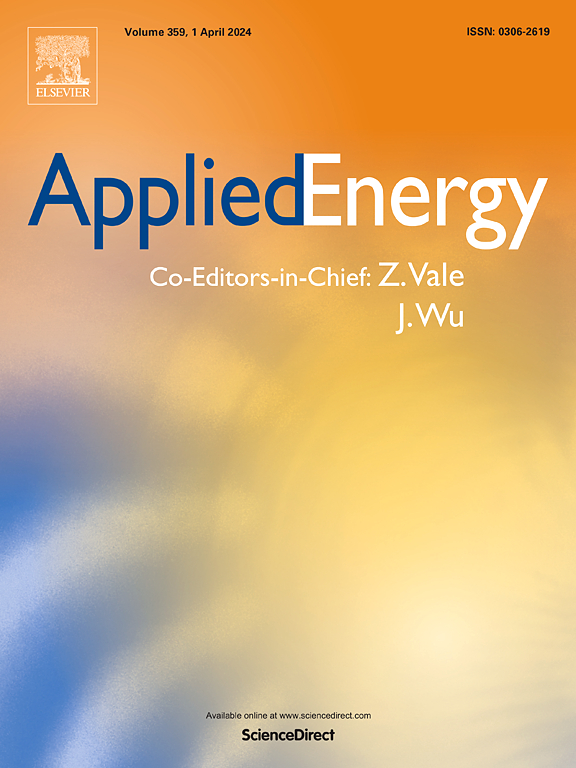深圳电动汽车充电站集热器驱动优化:智能充电、可再生能源整合和储能协同发展
IF 11
1区 工程技术
Q1 ENERGY & FUELS
引用次数: 0
摘要
电动汽车的广泛采用带来了诸如峰值负荷增加、电力基础设施加速退化和经济效率降低等重大挑战。为了解决这些问题,本研究提出了一个集成的多技术充电站模型,以及一个创新的分析框架,用于评估充电聚合器的综合效益。该框架将随机负荷预测模型与智能充电策略相结合,并使用来自中国深圳1682个充电站(包括24,798个单独的充电桩)的真实数据进行了验证。实施拟议的充电站模式,结合深圳的分时电价结构和80%的可再生能源渗透率,每千瓦时可降低0.38元的平准化能源成本、碳排放和峰值负荷。此外,可再生能源在智能充电系统中减少了44.01%的碳排放,超过了按需充电系统41.24%的碳排放量。此外,智能充电和按需充电方式将峰值负荷分别降低了30.03%和15.40%。研究发现,储能与智能充电相结合可以有效缓解其对排放和成本的负面影响。在按需充电场景下,储能系统增加了年碳排放量(从140.2万吨增加到1688万吨),而在智能充电场景下,储能系统减少了碳排放量。尽管目前深圳电动汽车充电资源分布不均,利用率低,导致充电聚合商出现财务亏损,但预计充电需求的快速增长和利用率的提高将大幅提高盈利能力。总体而言,本研究为充电基础设施的可持续发展提供了理论基础,从而增强电网稳定性和可再生能源的整合。本文章由计算机程序翻译,如有差异,请以英文原文为准。

Aggregator-driven optimisation of electric vehicle charging stations in Shenzhen: Synergising smart charging, renewable energy integration and energy storage
The widespread adoption of electric vehicles (EVs) presents substantial challenges such as increased peak loads, accelerated power infrastructure degradation and reduced economic efficiency. To address these issues, this study proposes an integrated multi-technology charging station model alongside an innovative analytical framework for assessing the comprehensive benefits of charging aggregators. The framework integrated a randomised load forecasting model with a smart charging strategy and was validated using real-world data obtained from 1682 charging stations, comprising 24,798 individual charging piles, in Shenzhen, China. Implementing the proposed charging station model, combined with Shenzhen's time-of-use tariff structure and an >80 % renewable energy penetration rate, reduced levelised cost of energy, carbon emissions and peak load by 0.38 Yuan per kWh. Furthermore, renewable energy contributes to a 44.01 % reduction in carbon emissions in the smart charging system, outperforming the 41.24 % reduction observed in the on-demand charging system. Additionally, smart charging and on-demand charging methods reduce peak loads by 30.03 % and 15.40 %, respectively. It is found that combining energy storage with smart charging effectively mitigates their negative effects on emissions and costs. Energy storage increased annual carbon emissions (from 1.402 Mt. to 1.688 Mt) in an on-demand charging scenario, whereas it decreased them in a smart charging scenario. Although the current uneven distribution and low utilisation rate of EV charging resources in Shenzhen have resulted in financial losses for charging aggregators, the anticipated rapid growth in charging demand and improved utilisation rates are expected to substantially enhance profitability. Overall, this study provides a theoretical foundation for the sustainable development of charging infrastructure, thereby enhancing grid stability and renewable energy integration.
求助全文
通过发布文献求助,成功后即可免费获取论文全文。
去求助
来源期刊

Applied Energy
工程技术-工程:化工
CiteScore
21.20
自引率
10.70%
发文量
1830
审稿时长
41 days
期刊介绍:
Applied Energy serves as a platform for sharing innovations, research, development, and demonstrations in energy conversion, conservation, and sustainable energy systems. The journal covers topics such as optimal energy resource use, environmental pollutant mitigation, and energy process analysis. It welcomes original papers, review articles, technical notes, and letters to the editor. Authors are encouraged to submit manuscripts that bridge the gap between research, development, and implementation. The journal addresses a wide spectrum of topics, including fossil and renewable energy technologies, energy economics, and environmental impacts. Applied Energy also explores modeling and forecasting, conservation strategies, and the social and economic implications of energy policies, including climate change mitigation. It is complemented by the open-access journal Advances in Applied Energy.
 求助内容:
求助内容: 应助结果提醒方式:
应助结果提醒方式:


